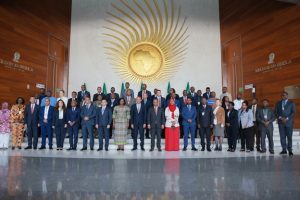
BY HAFTU GEBREZGABHIER
Built by the Ministry of Innovation and Technology, the Ethiopian Talent Development Institute which is located in Burayu city administration in the Oromia Regional State is set to play a significant role in Ethiopia’s efforts in job creation and human resource capacity building.
The Minister of Labor and Employment Muferiat Kamil, Innovation and Technology Honorable Belete Mola (Ph.D) along with senior leaders of the both ministries and executives of the Institute and other senior government officials have been visited the institute.
According to Minister Muferiat Kamil, the construction of the institute will play a significant role in Ethiopia’s efforts in job creation and human resource capacity building.
The Minister, who was briefed on the purpose of the institute and the level of construction it has reached at this time, said that the institute should be linked with technical and vocational training and development institutions. For this end, we will make efforts to provide the necessary assistance to achieve the visions of the institute.
Innovation and Technology, Belete Mola for his part stated that the role of stakeholders is crucial for the institute to achieve its goals. “In particular, the Ministry of Labor and Skills, which is leading the mission of training and skills to produce the country’s technically qualified manpower, has a significant role to play.
For example, based on the needs of the institute, the evaluation of users and talents, he said, when the talents complete their projects and training, they will play a major role in expanding their knowledge and multiplying their preliminary products for the benefit of the general public.”
The institute was established to identify and select talented young people from all over Ethiopia in the field of technology and engineering to develop their talents and in return translate them into action without interrupting their regular education.
The establishment decree of the institute has been approved and it will officially start operating as soon as the necessary regulations are approved. Currently, it is known that the institution is bringing together creative Ethiopians and helping them to bring their products to fruition.
Meanwhile the Ministry of Innovation and Technology is working to empower women in order to create their own jobs using their talents, support national needs and grow their economies by raising awareness of digital knowledge, skills and abilities.
For her part, the State Minister of Innovation and Technology Huria Ali emphasized that women should be benefited from the empowerment efforts in the digital sector to speed up the national development.
The State Minister stated that women are not able to fully utilize their potential due to the cultural, institutional and individual influence in our country, which has been affecting the economic growth.
Since the role of digital technology is great, starting from institutions and making it accessible to others, the efforts of empowering women to utlize technology through online and face-to-face training will continue, Huria stressed.
Talent development is globally considered as a unique business process that benefits both employees and organizations. By fueling employee growth and organizational success, it’s a true win-win proposition. Exceptional talent development programs don’t develop overnight, but with a focus on defined goals and strong two-way communication, they’re within the reach of every company.
When it comes to talent management, the twenty-first century is a battlefield. Some creative people consider today’s job market to be a seller’s market. Loyalty to a single boss, or even a single career path, is more often the exception than the rule.
To better control their human capital resources, forward-thinking companies must reconsider their approach to talent management. The aforementioned companies would be better placed to compete in a highly competitive market as a result of their actions.
According to the Society for Human Resource Management – SHRM, the task of HR has evolved tremendously over the years to include a broad range of organizational initiatives such as training, workforce growth, diversity and equality in the workplace, disaster preparedness, incentive management, and the development and implementation of organizational strategy.
The Society for Human Resource Management – SHRM promotes businesses to invest in human resources on a continuous basis, with “HR leaders serving as business partners while working closely with senior management to attract, recruit, grow, and retain talent,” according to the organization.
Talent management has been described as a multi-faceted strategic concept championed by HR practitioners. It is a source of competitive advantage and an integrated set of enterprise-wide, technology enabled, evidence-based HRM policies and practices.
The benefits of an effectively implemented talent management strategy include improved employee recruitment and retention rates and enhanced employee engagement. Steps to implementing an integrated talent management strategy include defining what is meant by talent management and its objectives.
Establishing talent assessment, data management and analysis systems and ensuring people have the necessary analytical skills. Conduct an audit of all HRM practices in relation to evidence-based best practices. Making changes and formalizing processes as required. Talent management is an integral part of a healthy organization on many levels.
Competition is fierce in today’s corporate world, with many HR professionals agreeing that there’s an ongoing “war for talent” —many open positions with not enough high-quality candidates to fill them. Talent management also works to keep current employees and advance them to higher positions in the organization. This saves money that could otherwise be lost to high employee turnover. “It makes much more sense to develop and retain key talent than source, hire and train new ones. These dynamics make the HR work vital.
The Ethiopian Herald September 30/2022




